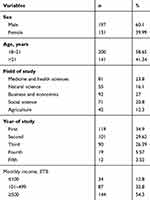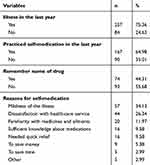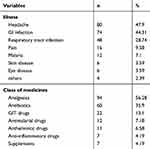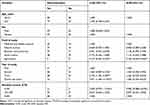Back to Journals » Risk Management and Healthcare Policy » Volume 13
Self-Medication Practices among Undergraduate University Students in Northeast Ethiopia
Authors Zewdie S, Andargie A, Kassahun H
Received 5 June 2020
Accepted for publication 10 August 2020
Published 26 August 2020 Volume 2020:13 Pages 1375—1381
DOI https://doi.org/10.2147/RMHP.S266329
Checked for plagiarism Yes
Review by Single anonymous peer review
Peer reviewer comments 4
Editor who approved publication: Professor Marco Carotenuto
Segenet Zewdie,1 Assefa Andargie,2 Haile Kassahun1
1Department of Pharmacy, College of Medicine and Health Sciences, Wollo University, Dessie, Ethiopia; 2Department of Epidemiology and Biostatistics, School of Public Health, College of Medicine and Health Sciences, Wollo University, Dessie, Ethiopia
Correspondence: Haile Kassahun Department of Pharmacy
College of Medicine and Health Sciences, Wollo University, Dessie, Ethiopia
Email [email protected]
Background: Inappropriate self-medication is a public-health problem worldwide. Major problems associated with self-medication include wastage of resources, increased resistance of pathogens, and adverse drug reactions.
Objective: The aim of this study was to assess self-medication practices and associated factors among undergraduate Wollo University students in Northeast Ethiopia.
Methods: A cross-sectional study was conducted among 341 undergraduate university students using a pretested and self-administered questionnaire from January to February 2019. Simple random sampling was used to select study participants. Data were collected using the self-administered questionnaire and analyzed with SPSS version 20. Multiple logistic regression was employed in data analysis, with P< 0.05 considered statistically significant.
Results: The prevalence of self-medication in this study was 64.98%. Mildness of disease (57, 34.13%) and dissatisfaction with health-care services, (44, 26.34%) were the main reasons for self-medication practice. The most common types of diseases for self-medication were headache (80, 47.9%), gastrointestinal infections (74, 44.31%), and respiratory tract infections (48, 28.74%). Analgesics (94, 56.28%) and antibiotics (60, 35.9%) were the leading classes of medicine used in self-medication. Multivariate regression analysis indicated that agriculture students (AOR 0.163, 95% CI 0.049– 0.545) were 84% less likely to practice self-medication than medicine and health-science students.
Conclusion: This study revealed that self-medication practices are common among study participants and significantly associated with their field of study. Awareness promotion on the risk of inappropriate self-medication for university students is highly recommended.
Keywords: self-medication practices, undergraduate university students, Ethiopia
Background
Self-medication is the use of medications without prior medical consultation on indication, dosage, or duration of treatment.1 Proper use of self-medication can benefit the individual’s health and is recognized by the WHO as part of self-care. It can help treat minor ailments that do not require medical consultation. Even though self-medication is a useful tool to treat minor ailments, improper self-medication practice may lead to adverse drug reactions, inappropriate selection of medications, risk of double medication and harmful interactions, risks of dependence and abuse, over- and under dosing of medicines, and antimicrobial resistance due to irrational use of antibiotics.2,3 Nowadays, drug resistance is becoming a worldwide problem, mainly in developing countries as a result of the use of antibiotics without prescription. In many developing countries, antibiotics and potentially lifesaving medicines are easily available, and every pharmacy sells without prescription.4
Numerous studies have been conducted in different countries investigating self-medication practices among university students. High self-medication prevalence was reported among university students in Bangladesh (88%),5 Jordan (86.7%),6 Saudi Arabia (86%),7 and Egypt (52.7%).8 Similarly, a study conducted among students of Gadjah Mada University, Indonesia9 and Jiangsu University, China10 revealed that self-medication with antibiotics was practiced by 49% and 47.9% of the respondents, respectively. In Ethiopia, the prevalence of self-medication among university students across studies has been 32.7%–70.8%.11–13
According to previous studies, the most common reason reported for self-medication was previous experience, to save money and time, minor illness, seeking quick relief, suggestions from relatives/friends, personal convenience, ease of drug acquisiton, unsatisfied with service given and impoliteness of health-care practitioners.11–15 Similarly, the most common medical conditions that led students to self-medicate were cough and headache, followed by cold and fever. Other medical conditions mentioned by different studies have been sore throat, running nose, eye problems, diarrhea, malaria, gastrointestinal disorders, infection, skin problems, and dysmenorrhea.11,13,16,17 Antibiotics, analgesics, antipyretics, antacids, vitamins, cough remedies, eye drops, antihistamines, antimicrobials, and anti-inflammatory drugs are commonly used classes in self-medication.8,11-13,18,19
Inappropriate self-medication is a public-health problem worldwide.20 In developing countries, most illnesses are treated by self-medication, bringing much public and professional concern about irrational use of medicines. Despite the negative consequences of self-medication and its high spread, studies are limited in this area. Investigating self-medication among university students is important, as they constitute a segment of society that is highly educated and more inclined to provide information about medications to the community.11 As such, this study was carried out to assess self-medication practices and associated factors among undergraduate Wollo University students in Northeast Ethiopia.
Methods
Study Design and Study Area
A descriptive cross-sectional study was conducted from January to February 2019 among undergraduate students of Wollo University, northeast Ethiopia. The university has Dessie and Kombolcha campuses. This study was conducted in Dessie campus, located in Dessie town, 401 km far from the capital city of Ethiopia, Addis Ababa. There are six colleges in Dessie campus and five (i.e, medicine and health science, natural and computational science, social science and humanity, business and economics, and agriculture) were included in this study. There was a total of 7,330 regular undergraduate students during the study.
Source and Study Population
All regular undergraduate students at Wollo University, Dessie campus were the source population, whereas students in randomly selected colleges were the study population.
Sample-Size Determination
Sample size was determined using a single population–proportion formula with an assumption of the prevalence of self-medication at the University of Gondar of 32%,11 with confidence level of 95%, margin of error of 5%, and nonresponse rate of 10%:
n = (Z α/2)2×p(1–p)/(d)2 = (1.96)20.32(1–0.32)/(0.05)2 = 334.4
With the 10% nonresponse rate, 368 students were included in the study and the respondents were selected using random sampling.
Sampling Procedure
The study was conducted in five colleges of Wollo University, Dessie campus. Colleges and departments were selected using convenience sampling. Stratified Random sampling was then used to select the departments to be sampled from a list of the departments in five colleges. Twelve departments (pharmacy, public health officer, environmental health, statistics, biology, management, accounting, marketing, cooperative, law, anthropology, and history) were selected and proportional allocation was done according to the size of each department. Simple random sampling was employed to select study participants.
Measurement of Variables
Self-Medication
We assessed the use of medications without prior medical consultation on indications, dosage, and duration of treatment.1
Data-Collection Procedures
The questionnaire had items regarding sociodemographic characteristics and self-medication practices of the respondents. The questionnaire was translated to Amharic and back-translated into English, and a pilot study was done in 5% of the sample to ensure the validity of the data-collection instruments. Data were collected by six trained postgraduate pharmacy students using pretested self-administered structured questionnaires adapted from previously published articles11,21-23 and modified to achieve objectives.
Data Processing and Analysis
Data collected were checked for completeness and entered into SPSS version 23 for further analysis. Descriptive statistical analyses, such as frequencies and percentages, were computed and are presented using tables. Both bivariate and multivariate logistic regression was fitted to identify factors associated with self-medication. Variables with P<0.2 on bivariate analysis were fitted to the multivariate logistic regression. On multivariate analysis, P<0.05 was considered statistically significant.
Ethical Considerations
This study was conducted in accordance with the ethical guidelines of the Declaration of Helsinki and ethically approved by the College of Medicine and Health Sciences Research Ethics Review Committee at Wollo University, Ethiopia (protocol WU/Phar/258/11). Written informed consent was obtained from each participant before the questionnaires were distributed. The data gathered were anonymous, and study participation was entirely voluntary.
Results
Sociodemographic Characteristics of Respondents
Of the initial 368 study participants, 341 completed the questionnaire, for a response rate of 92.6%. Of the respondents, 197 (60.1%) were males. A majority of respondents (200, 58.6%) were aged 18–21 years. Three quarters of respondents (264, 77.41%) were Orthodox (Table 1).
 |
Table 1 Sociodemographic Characteristics of Study Participants (n=341) |
Self-Medication Practices
Among 341 study participants, 257 (75.36%) reported illness in the last year. Of these, a majority (167, 64.98%) had practiced self-medication. Mildness of the illness (57, 34.13%), dissatisfaction with health-care services (44, 26.34%) and familiarity with medicines and ailments (20, 11.97%) were the main reasons for self-medication practices. Of those who practiced self-medication, 93 (55.68%) did not remember the name of the drug (Table 2).
 |
Table 2 Self-medication Practices Among Study Participants |
Indications and Drug Classes Used for Self-Medication
Common illnesses reported in this study were headache (80, 47.9%), gastrointestinal infections (74, 44.31%) and respiratory tract infections (48, 28.74%). The most common drug classes used in self-medication were analgesics (94, 56.28%) and antibiotics (60, 35.9%) (Table 3).
 |
Table 3 Indications and Drug Classes Used for Self-Medication Among Study Participants (n=167) |
Source of Drugs for Self-Medication Practices
A majority of respondents accessed drugs from pharmacies (98, 58.68%). Left-over medications (42, 25.14%), suggestions from family/friends (18, 10.77%), previous prescriptions for similar diseases ( 7, 4.19%), and “others” ( 5, 2.99%) were also mentioned as drug sources for self-medication practices.
Factors Associated with Self-Medication Practices
On logistic regression analysis, self-medication was the dependent variable and sociodemographic characteristics were independent variables. Binary logistic regression followed by multiple logistic regression was carried out to identify independent predictors for self-medication. On binary logistic regression analysis, field of study, year of study, and monthly income were associated with self-medication practices. In addition, the results of multivariate logistic regression analysis revealed that field of study was significantly associated with self-medication practices. Agriculture students (AOR 0.163, 95% CI 0.049–0.545) were 84% less likely to practice self-medication than medicine and health-science students (Table 4).
 |
Table 4 Factors Associated with Self-Medication Among Respondents (n=257) |
Discussion
Several studies have revealed that self-medication practices are common and prevalence varies throughout the world. This study was designed to assess self-medication practices and associated factors among undergraduate university students in Northeast Ethiopia. According to this study, the prevalence of self-medication in the last year was 64.98%. Similar findings have been reported in studies conducted among university students in Uganda (63.5%),24 Kolkata, India (65%),25 and Pakistan (66.2%).26 Our finding was higher than studies done among university students in Gondar, Ethiopia (38.5%)12 and Mekelle, Ethiopia (43.24%).27 However, it was lower than studies done in Eritrea (79.2%),21 Nigeria (81.8%),23 Pakistan (99%),28 Palestine (98%),29 south India (78.6%),30 Serbia (79.9%),31 and Jordan (96.8%).32 This variation may be due to differences in educational background and socioeconomic characteristics of study participants, clinical exposure, and variations in recall periods used.
In the present study, mildness of the disease (34.13%), dissatisfaction with health-care services (26.34%), and familiarity with medicines and ailments (11.97%) were the main reasons for self-medication practice. This result is similar to studies conducted among university students in North India,33 Bangladesh,5 Brazil,34 Nigeria,14 and Ethiopia.13 Treatment on the basis of previous experience may result in misdiagnosis and incorrect choice of drugs, since diseases may share similar symptoms.
Headache (47.9%) was the most commonly reported illness that led to self-medication, and comparable findings have been reported by previous studies.27,31,32,35-41 Analgesics (56.28%) were the most commonly used category of medicines, comparable to previous reports.11,23,24 This could be due to most respondents believing analgesics to be atoxic drugs that can be used at any time, irrespective of the dosage. Analgesics are over-the-counter drugs, i.e., sold without prescriptions.
Antibiotics (35.9%) were the second most used drugs in self-medication, which should be considered an alarming problem, as misuse of these drugs is a threat due to development of drug resistance. A high prevalence of self-medication with antibiotics has been reported among health-science students in Arsi, Ethiopia (58%).13 This is likely due to the respondents being health-science students and recall as well as use of antibiotics could have been increased. In addition, types and rates of self-medication drugs vary with time and area, due to differences in countries’ approved over-the-counter drugs, accessibility of the drugs, the country’s drug-regulation system, disease, and patient’s condition, as well as experiences of health-care providers. Inappropriate use of antimicrobials is known to be common in developing countries, and these can be obtained from pharmacies without prescription despite being prescription-only medicines. This might lead to spread of antibiotic resistance, adverse drug reactions, and treatment failure.4,12 It is very important to discourage self-medication with antibiotics and thus health-education intervention regarding the risks of inappropriate self-medication with antibiotics is essential.
Most drugs for self-medication were accessed from pharmacies (58.68%), which is relatively similar to previous studies.21,23,24,27 Easy accessibility of medicines, including those dispensed with a physician’s prescription, from pharmacies could be related to the absence of a strong regulatory system in the country. This could lead to an increasing number of individuals practicing self-medication, thus leading to irrational drug use and potential development of drug resistance. In this study, results of multivariate logistic regression analysis indicated that agriculture students were less likely to practice self-medication than medical students. In contrast to this, studies have reported that non–medical students are more likely to practice self-medication.29 This is likely due to health professionals being familiar with the medications used in the management of their disease conditions.
This study was designed to assess self-medication practices and associated factors among undergraduate university students at Wollo University, Northeast Ethiopia. However, there were also some limitations to this work. Recall bias is possible, as students were asked about their experience in the past 12 months. The results were also based on self-report and so with the possibility of over- and under reporting. Since this study included students from all departments, they may not have known classification or name of the drug they took. Furthermore, the cross-sectional study design used did not allow for a cause–effect relationship to be concluded from the results of the study.
Conclusion
This study revealed that self-medication practices were common among undergraduate university students in Northeast Ethiopia, and significantly associated with field of study of the respondents. Headache and gastrointestinal diseases were the most commonly reported conditions in self-medication practices. Mildness of disease and dissatisfaction with health-care services were the main reasons for self-medication practices. Analgesics and antibiotics were the most commonly used classes in self-medication. The use of prescription drugs without prescription should be discouraged and hence health professionals, particularly community pharmacists, should provide health education to raise awareness of the consequences of inappropriate self-medication practices.
Data-Sharing Statement
All data are included within the manuscript.
Acknowledgment
The authors would like to thank study participants involved in this study.
Funding
No funding was obtained to conduct this study.
Disclosure
The authors declare that they have no competing interests.
References
1. Organization WH. The Role of the Pharmacist in Self-Care and Self-Medication: Report of the 4th WHO Consultative Group on the Role of the Pharmacist. The Hague, The Netherlands: World Health Organization; 1998
2. Mamo S, Ayele Y, Dechasa M. Self-medication practices among community of harar city and its surroundings, Eastern Ethiopia. J Pharm. 2018;2018:1.
3. Organization WH. General policy issues-the benefits and risks of self-medication. WHO Drug Information. 2000;14:1–2.
4. Jember E, Feleke A, Debie A, Asrade G. Self-medication practices and associated factors among households at Gondar town, Northwest Ethiopia: a cross-sectional study. BMC Res Notes. 2019;12(1):1–7. doi:10.1186/s13104-019-4195-2
5. Seam M, Reza O, Bhatta R, et al. Assessing the perceptions and practice of self-medication among Bangladeshi undergraduate pharmacy students. Pharmacy. 2018;6(1):6. doi:10.3390/pharmacy6010006
6. Alsous M, Elayeh E, Jalil MA, Alhawmdeh E. Evaluation of self-medication practice among pharmacy students in Jordan. Jordan J Pharm Sci. 2018;11:1.
7. Sharif SI, Ibrahim OHM, Mouslli L, Waisi R. Evaluation of self-medication among pharmacy students. Am J Pharmacol Toxicol. 2012;7(4):135–140. doi:10.3844/ajptsp.2012.135.140
8. Ramadan M, Eltaweel A, El Nakhal T, et al. Self-medication among undergraduate medical students of alexandria faculty of medicine: where do we stand? Int J Med Students. 2018;6(2):52–55. doi:10.5195/ijms.2018.41
9. Sandhu S, Suryani Y, Dwiprahasto I, Atthobari J. A survey of antibiotic self-medication and over the counter drug use among undergraduate medical students in yogyakarta, Indonesia. Southeast Asian J Tropical Med Public Health. 2017;48(6):1290–1298.
10. Zhu X, Pan H, Yang Z, Cui B, Zhang D, Ba-Thein W. Self-medication practices with antibiotics among Chinese university students. Public Health. 2016;130:78–83. doi:10.1016/j.puhe.2015.04.005
11. Gelayee DA. Self-medication pattern among social Science University students in Northwest Ethiopia. J Pharm. 2017;2017.
12. Abay S, Amelo W. Assessment of Self-medication practices among medical, pharmacy, health science students in Gondar University, Ethiopia. J Young Pharmacists. 2010;2(3):306–310. doi:10.4103/0975-1483.66798
13. Bekele SA, Argaw MD, Yalew AW. Magnitude and factors associated with self-medication practices among university students: the case of Arsi University, College of Health Science, Asella, Ethiopia: cross-sectional survey based study. Open Access Library J. 2016;3(6):1–15.
14. Idoko C, Omotowo B, Ekwueme O, et al. Prevalence and pattern of self-medication among medical students in a Nigerian University. Int J Med Health Development. 2018;23(1):189.
15. Musa Y, Awosan K, Ibrahim M, et al. Knowledge and practice of self-medication among undergraduate students of Usmanu Danfodiyo University, Sokoto. Ann Int Med Den Res. 2016;2(1):83–88.
16. Verma RK, Mohan L, Pandey M. Evaluation of self medication among professional students in North India: proper statutory drug control must be implemented. Evaluation. 2010;3(1):60–64.
17. Emmanuel A, Daniel G, Achema G, Afoi B, Onyejekwe G, Gimba S. Self-medication Practice among undergraduate nursing students of university of Jos, Nigeria. Nig J Pharm Sci. 2011;10:22–26.
18. Haghighi S, Ashrafizadeh H, Sayadi N. Self-medication and related factors among university students in Iran. Journal of Nursing and Midwifery Sciences 2016 :3 (2): 47-51.
19. Mosaddek ASM, Haque M, Islam Z, et al. Practice of self-medication among students of a selected medical college of Dhaka City, Bangladesh. Int Med J. 2017;24(2):225–229.
20. Nepal G, Bhatta S. Self-medication with Antibiotics in WHO Southeast Asian Region: a systematic. Cureus. 2018. doi:10.7759/cureus.2428
21. Araia ZZ, Gebregziabher NK, Mesfun AB. Self medication practice and associated factors among students of Asmara College of Health Sciences, Eritrea: a cross sectional study. J Pharm Policy Practice. 2019;12(1):3. doi:10.1186/s40545-019-0165-2
22. Kassie AD, Bifftu BB, Mekonnen HS. Self-medication practice and associated factors among adult household members in Meket district, Northeast Ethiopia, 2017. BMC Pharmacol Toxicol. 2018;19(1):15. doi:10.1186/s40360-018-0205-6
23. Esan DT, Fasoro AA, Odesanya OE, Esan TO, Ojo EF, Faeji CO. Assessment of self-medication practices and its associated factors among undergraduates of a private University in Nigeria. J Environ Public Health. 2018;2018.
24. Niwandinda F, Lukyamuzi EJ, Ainebyona C, Ssebunya VN, Murungi G, Atukunda EC. Patterns and practices of self-medication among students enrolled at Mbarara University of Science and Technology in Uganda. Integrated Pharmacy Research Practice. 2020;9:41. doi:10.2147/IPRP.S237940
25. Pal J, Ahmad S, Pal P, Chatterjee D. Prevalence and pattern of self-medication among undergraduate students in a medical college of Kolkata. Int J Community Med Public Health. 2017;4(10):3619–3624. doi:10.18203/2394-6040.ijcmph20174221
26. Ali H, Naureen ON, Ahmad A, Yasmeen S, Mehmood R, Arshad A. Assessment of self-medication among medical and non-medical students. Biomedica. 2015;31(4):311.
27. Gutema GB, Gadisa DA, Kidanemariam ZA, et al. Self-medication practices among health sciences students: the case of Mekelle University. J Appl Pharm Sci. 2011;1(10):183.
28. Kanwal ZG, Fatima N, Azhar S, Chohan O, Jabeen M, Yameen MA. Implications of self-medication among medical students-A dilemma. J Pak Med Assoc. 2018;68(9):1363–1367.
29. Sawalha AF. A descriptive study of self-medication practices among Palestinian medical and nonmedical university students. Res Social Administrative Pharmacy. 2008;4(2):164–172. doi:10.1016/j.sapharm.2007.04.004
30. Kumar N, Kanchan T, Unnikrishnan B, et al. Perceptions and practices of self-medication among medical students in coastal South India. PLoS One. 2013;8(8):e72247. doi:10.1371/journal.pone.0072247
31. Lukovic JA, Miletic V, Pekmezovic T, et al. Self-medication practices and risk factors for self-medication among medical students in Belgrade, Serbia. PLoS One. 2014;9(12):e114644. doi:10.1371/journal.pone.0114644
32. Alshogran OY, Alzoubi KH, Khabour OF, Farah S. Patterns of self-medication among medical and nonmedical University students in Jordan. Risk Manag Healthc Policy. 2018;11:169. doi:10.2147/RMHP.S170181
33. Parakh R, Sharma N, Kothari K, Parakh R, Parakh P. Self-medication practice among engineering students in an engineering college in North India. J Phytopharm. 2013;2:30–36.
34. Gama ASM, Secoli SR. Self-medication among nursing students in the state of Amazonas–Brazil. Rev Gaúcha Enferm. 2017;38(1):e65111.
35. Latifi A, Ramezankhani A, Rezaei Z, et al. Prevalence and associated factors of self-medication among the college students in Tehran. J Appl Pharm Sci. 2017;7(7):128–132.
36. Sawalha AF. Assessment of self-medication practice among university students in Palestine: therapeutic and toxicity implications. IUG J Natural Studies. 2015;15:2.
37. Syed N, Naseer M, Memon MQ, Rani K. Prevalence of self-medication and its practice among the medical and non-medical students. JLUMHS. 2014;13(02):79.
38. Shankar PR, Dubey AK, Dwivedi NR, Nandy A, Barton B. Knowledge, perception and practice of self-medication among premedical and basic science undergraduate medical students. Asian J Med Sci. 2016;7(6):63–68. doi:10.3126/ajms.v7i6.15246
39. Khandelwal S, Deb D, Gonsalves J. Practice of self-medication among medical students in Manipal. Int Res J Pharm Applied Sci. 2013;3(5):175–179.
40. Idris T, Khanum S, Uddin MS, et al. Study on self-medication practices among university students of Bangladesh. J Adv Med Medical Res. 2016;1–8.
41. Albasheer OB, Mahfouz MS, Masmali BM, et al. Self-medication practice among undergraduate medical students of a Saudi tertiary institution. Tropical J Pharm Res. 2016;15(10):2253–2259. doi:10.4314/tjpr.v15i10.26
 © 2020 The Author(s). This work is published and licensed by Dove Medical Press Limited. The full terms of this license are available at https://www.dovepress.com/terms.php and incorporate the Creative Commons Attribution - Non Commercial (unported, v3.0) License.
By accessing the work you hereby accept the Terms. Non-commercial uses of the work are permitted without any further permission from Dove Medical Press Limited, provided the work is properly attributed. For permission for commercial use of this work, please see paragraphs 4.2 and 5 of our Terms.
© 2020 The Author(s). This work is published and licensed by Dove Medical Press Limited. The full terms of this license are available at https://www.dovepress.com/terms.php and incorporate the Creative Commons Attribution - Non Commercial (unported, v3.0) License.
By accessing the work you hereby accept the Terms. Non-commercial uses of the work are permitted without any further permission from Dove Medical Press Limited, provided the work is properly attributed. For permission for commercial use of this work, please see paragraphs 4.2 and 5 of our Terms.
